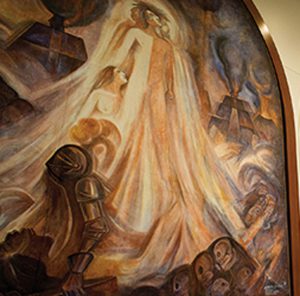SD’s Introduction to Chicano Mural Art Rededicated at SDSU

Gilberto Ramirez, an apprentice to Mexican muralist David Alfaro Siqueiros and who introduced mural art to San Diego’s Chicana/o movement, was honored and his influence expounded upon on Thursday March 6, 2014 at a rededication ceremony. The three-panel “Triptico” mural painted by Gilberto Ramirez and two students: Guillermo Aranda and Ruben DeAnda – Aranda was a SDSU Student and DeAnda was a student at a community college – is stunningly displayed inside of San Diego State University’s brand-new Montezuma Hall. The original 1968 Aztec Center was torn down, to be rebuilt as the new three-story C.P.A. Student Union for today’s larger student body.
The Mural Triptico Re-Dedication Ceremony consisted of four speakers who gave their affiliation to the “Triptico” mural and created a visual of the times when “Triptico” was painted.
Seth Mallios, Chair, Department of Anthropology, SDSU was the Master of Ceremonies and is a self-proclaimed “historian and mural fanatic.” Mallios described “Triptico” as a “Three-part masterpiece which tells the past, present and future of the Chicana/o movement as it was in 1970 when painted by muralist Gilberto Ramirez and two SDSU students, Guillermo Aranda and Ruben DeAnda.”
Mallios explained that “The first panel shows the Spanish conquest of Mexico and the near-total destruction of the indigenous Mexican culture.” It is entitled ‘Crepusculo’ or sunset as in the end of the people of the sun. The second panel represents the darkness of isolation and is called “Noche” and shows the International border separating Mexican and American Chicanos, depicting us as trapped in a mechanized world without art or tradition, stated Mallios. The third panel is called “‘Amanecer’ or dawn and represents the germination of new life, encapsulating an “Optimistic future and a multicultural world of youth, vibrancy and creativity.
Mallios stated that “nural art has always been a people’s art especially in traditions evolving from the early 20th Century Mexican Mural Movement. Inspired by legendary artists such as Riviera, Orozco, Siquieros and Tamayo. No art is more democratic than mural art.”
“Ramirez is the genius behind these three-panels, “stated Mallios, and that Ramirez came to the US to learn more about the local Chicana/o movement and was thoroughly inspired by the young people he met; so much so that he passed his gift on to students Guillermo Aranda and Ruben DeAnda.” In closing, Mallios said, “masters pass on their craft to others. Gilberto Ramirez passed on his gift.”
Jim Brega an alumni told how Ramirez had given Jim’s late sister, Rebecca, the original concept drawing. In 2009, Brega donated the drawing back to SDSU. He described the tumultuousness during the late 1960’s and early 70’s. There was the Vietnam War and the draft. “SDSU was on the lecture circuit” for all types of speakers including Cesar Chavez and Martin Luther King, Jr. Also, SDSU was a mecca for student activism which included building takeovers protesting the war, thus, demonstrating “The belief in the curative power of protest.”
Dr. Norma Iglesias-Prieto, Chair, Department of Chicana & Chicano Studies, SDSU. Iglesias-Prieto opened with, “If walls could talk.” She said “in order to understand a mural is to understand the context of the time” and “murals are like a graphic text book…‘Triptico’ is the epitome.”
Next, was my uncle, Guillermo Aranda. He said that you can’t imagine all the feelings that were going through him as he was seeing the mural again, after so many years and in this beautiful setting. He was overcome by emotion. “There was a lot happening then and Ramirez put a fire in me” said Aranda.
Before apprenticing with Ramirez, Aranda’s art was on sketch pads and canvas now Ramirez brought the idea of art on the walls for Aranda and it opened up a new world. Aranda looked at walls differently it was a paradigm shift in Aranda’s thinking and his art. At the time, Aranda was a student activist and an active member of MEChA where he worked with Ramirez to get funding for the mural, which was commissioned by MEChA and the ASB (Associate Student Body.)
Triptico was started on the walls in the Aztec Center in the fall of 1969, and completed in January of 1970.






